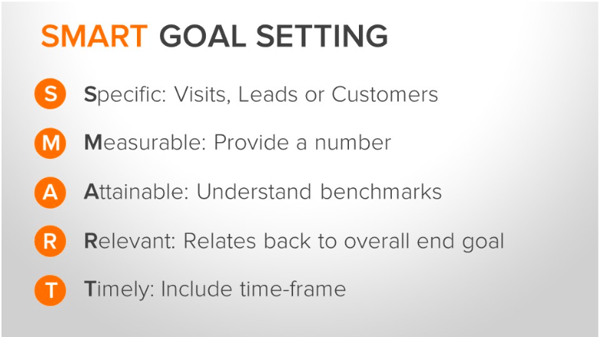
Every B2B organization needs an online marketing strategy, regardless of size, industry, or age. However, merely having a strategy isn’t enough. The strategy should be documented, tracked, and regularly honed so that your marketing campaigns continue to remain competitive and perform year after year.
Unfortunately, there is no one-size-fits-all marketing strategy for B2B companies. However, companies can structure their marketing efforts according to the size of their business.
SMBs
These small- and medium-sized B2B businesses should focus on branding, as well as expanding their exposure. They are up against immense amounts of competition and should be spending their resources on putting their name out there.
Large and Enterprise Businesses
These mega-corporations should determine if their goal is to attain growth or maintain stability. The answer will dictate where to steer the marketing campaigns and will help create the entire marketing strategy blueprint.
Steps to Build a B2B Online Marketing Strategy
No matter what size business you have, here are all the factors you’ll want to consider as you create your B2B marketing strategy:
1. Conduct Market Research
Research is paramount if you hope for your campaign to get off on the right foot. It’s easy to get lost in the research. Therefore, you can make your time spent researching your market more efficient by asking the following questions:
1. Where is my company positioned?
What is your target niche and what are the names and value offerings of the companies operating within the same space?
2. What are the drivers of the industry and my business?
This is where you’ll identify the gaps in the market your company serves to fill. It pinpoints the problems and issues your target audience faces that your company can help solve. It also offers up some predictions for the future and the direction your company hopes to travel to satisfy customers in the long term.
Here you can also list any perceived gaps in the market that could make your business obsolete or that could harm your company’s market position.
3. What Differentiates Us from Other Companies?
What sets you apart from those competitors? Why do customers choose their offerings over others? What are your company’s strengths and weaknesses, and what are those of the competition?
4. Who are my ideal clients?
In order to sell effectively online, you need to define your buyer personas. Your buyer personas are a representation of the ideal customer. You’ll want to get as detailed as possible when fleshing out your buyer persona, such as giving him or her a name, job title, organization, and yearly salary.
All demographics information should be explored, including age, location, and type of living arrangement. You can delve into hobbies, likes and dislikes, and buying habits, too.
All your blog posts should be written with your personas in mind. All ebooks and email communications will be targeted toward your persona’s problems, and the ways your company can solve them.
2. Document Your Buyer’s Journey
Traditional marketing has given way to clients doing more self-investigation than ever before. That means that 80% of the buying process occurs without any human-to-human interaction.
Therefore, it becomes important to track the buyer’s journey as they go from first learning about your company to actually doing business with you.
To effectively track the buyer’s journey, it becomes important to delve into your buyer persona’s thought process as they flow through your marketing funnel.
The buyer’s journey consists of three primary stages that are referred to as Awareness (Top of Funnel), Consideration (Mid-Funnel), and Decision (Bottom of Funnel).

- Awareness: Most prospects will enter your conversion funnel asking important questions in an effort to solve a pressing problem.
- Consideration: As the individual progresses through the funnel, he or she will begin evaluating all available solutions.
- Decision: At the bottom of the funnel, the prospect begins looking for the best vendor or partner to provide the solution to their problem. This is where your organization is compared to others with similar offerings in your field.
B2B buyers want four things before they will decide to do business with a company.
- Industry & Company Knowledge: Prospects want to know that your company understands their field, organization goals, and overall mission statement.
- Thought Leadership: Buyers are most interested in those brands that showcase expertise in their industry’s subject matter.
- Valuable Resources: Discerning buyers will be more attracted to brands that provide useful and free resources, like blogs, whitepapers, and newsletters.
- Understanding of Products & Services: Before they commit, buyers want to know that your organization has a deep understanding of their offerings and the value they bring to the marketplace.
Once you know this information, you can more easily target your buyer personas across the varied levels of the buyer’s journey.
3. Clearly Define Your Goals
Goals should always be SMART. That is, they should be Specific, Measurable, Achievable, Relevant and Timely.

Specific: Your goal should be clear so that there is no confusion, such as your desire to earn 10 new clients in the next month.
Measurable: Part of being specific means that you should be able to measure your progress, such as earning 30 more leads or 100 new subscribers to your newsletter.
Attainable: Your goal should be within your reach. While earning $10 million in a year might be a tad lofty, increasing your revenue by 10- 20% this year could certainly be within the realms of possibility.
Relevant: Your goals should align with your overall mission statement and campaign objectives. For instance, if your goal is more social outreach, then focusing on Facebook, Twitter, and LinkedIn marketing would definitely hold relevance.
Timely: Give your goal a deadline, such as this week, month, or year.
For many B2B marketers, establishing clear-cut SMART goals can be a bit of a challenge. Usually, this is the result of a misalignment between marketing and sales. Throughout history, there’s been a rift between the two departments. Marketing feels that sales doesn’t appreciate their value, while sales complains about the lack of SQLs.
The truth is, without alignment between marketing and sales, your organization won’t be be able to achieve its business goals. That means others competing against you could surpass your organization, merely by attaining a level of alignment that HubSpot calls “Smarketing”.

In order to align your marketing and sales departments and determine common business goals, keep the following points in mind:
- Agree on key metrics: Marketing and sales should have interdependent goals, and compensation should be based on these shared goals.
- Regular meetings: It’s important to bring both groups together to discuss challenges and solutions. These meetings are also important for ongoing discussion and education about buyer personas.Typically, any rift between marketing and sales is caused by a lack of communication.
- In-Depth feedback: Sales are on the front lines, and they know what customers are feeling, the questions they have, and the objections that need to be overcome. The system of closed loop reporting is necessary here, so that all data collected is used appropriately and that no stones are left unturned when it comes to satisfying buyers’ growing needs.
4. Determine How You Will Analyze Your Results
Crunching the numbers and reviewing incoming data are critical to progress so that you can tweak and optimize your marketing campaigns over time. There are essentially three ways to analyze just how much your campaigns are performing.
KPIs:
Key Performance Indicators or KPIs can indicate any method of measurement that aligns with your marketing goals, such as clicks to your website, downloads of your newsletter, and subscribers to your YouTube channel.
Buying Behavior:
Once your campaign begins, you’ll begin to receive critical data about your visitor behavior. This information can be combined with your previous research to create an ultra-realistic snapshot of your buyer persona.
You can even go as far as to create separate marketing campaigns to target your buyer persona’s behavior. Using tools such as heatmaps, which can be found at Hotjar and ClickTale, you can track website visitors’ mouse movement and clicks. This information can then be used to optimize your online assets.

For instance, if you find that most visitors look to the top right of your website immediately upon landing, that spot might be ideal for your call-to-action.
Marketing Mix Modeling:
MMM is the technique that tests how much each marketing input contributes to sales, which indicates how much budget to spend on each aspect of marketing. This is crucial for calculating and assessing the company’s ROI.
Using MMM, you can determine which channels are most effective and how to put your marketing budget to the best use. Marketing mix modeling can also be used to predict how various channels will work in the future based on current data.
Hubspot is an example of software that provides marketing mix modeling. Hubspot can analyze your website performance, blog post clicks and read rates, social media engagement, and much more.
5. Determine Your Marketing Budget
You may get varied advice when asking about marketing budget. However, new companies would be best served by spending 12-20% of their gross revenue and 6-12% of gross revenue if the company is more established, according to information provided by WordStream.
The budget you select will also be determined by your marketing goals, the aggressiveness with which you want to achieve those goals, and how much your company has to invest.
6%, 12%, and 20% are just general guides. However, by conducting the proper research and using methods like marketing mix modeling, you will be able to use your marketing budget to its fullest potential, ensuring you’re one step closer to campaign success.
Building a Marketing Strategy That Suits Your Business
While building a successful B2B online marketing strategy is not a paint-by-the-numbers activity, these guidelines hold true for all organizations, big or small. Along with research, aligning marketing and sales, developing common goals, and devising the right marketing budget, companies should also ensure their marketing campaigns are focused on client issues, infused with emotion, and based on forming long-lasting professional relationships.
Now that you have a few B2B marketing best practices to work with, you should be ready to proceed with building your marketing strategy implementation plan. Just remember that you will need to continually review and update your marketing plan and test new theories and initiatives as market conditions evolve and your clients’ needs change.
If you need guidance, contact Keyscouts today! We will be happy to help.







